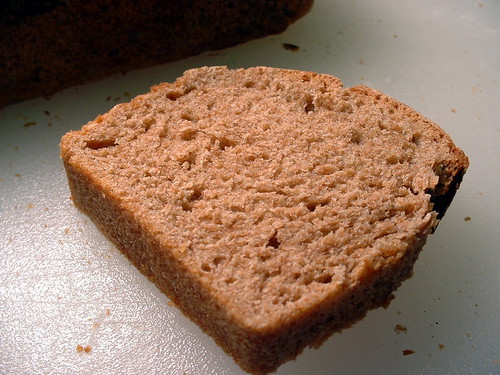I promised healthier after my eggs and cheese and butter extravaganza in the previous post, so here's the Sweet Spelt Sourdough Bread from King Arthur Flour Whole Grain Baking.

Spelt is a new grain for me. The natural store that I shop at carries it, and I got a 1 lb bag on a whim a couple of months ago. I haven't found tons of recipes using spelt, as it's only recently started gaining popularity. This sourdough recipe not only provided a way to use some of the spelt that I'd bought, but also gave me an excuse to poke my starter and see if it was still going strong after several months hibernating in the refrigerator (answer: Yes. Sweet Fancy Moses, yes. It'll probably outlive me.).
The recipe calls for an all-spelt levain. Bakers have a whole bunch of terms that mean "starter".. levain is one of them. It's kind of an intermediate step between your permanent starter and the finished dough. Basically, take a little bit of your starter, feed it, and that's your levain. This recipe actually calls for you to begin with a spelt starter... my starter is good ol' AP flour and bread flour, and I absolutely wasn't going to convert the whole thing to spelt just for the 2 tablespoons that are used to make the levain. I used two tablespoons of my existing starter, fed it with the amounts of spelt and water specified, and set it on my warm oven to ferment. ("Room temperature" for bread tends to be warmer than my room temperature here. Any time I see that something needs to rise at room temperature, I turn on the oven as low as possible and set the rising container on top.)
Now, here's where my fun really started. The basic sourdough recipe that I've made in the past calls for the levain to expand for up to 16 hours... my yeast does this in 4 hours. Using the (faulty) assumption that I would also have a faster rise with this one, I started its 12-hour rise at 5:30 pm on Friday. I figured, even if it took half the time called for, I'd still be able to make the dough around 11:30, nap during rise times, and take fresh baked bread in to work with me Saturday morning.
Of course, this time it took the full 12 hours to rise. I stashed it in the fridge so it wouldn't continue to expand so quickly while I was at work and then out Saturday evening. I got the levain out on Sunday morning, let it come up to room temperature, and then made my dough. This dough was hard as a rock. It sucked up all the liquid and still left about half a cup of dry flour on the bottom of the bowl. I added enough water to make a very wet and loose dough with the flour that hadn't been absorbed, and folded that into the rest of the dough. Slowly, it started to loosen up to a point where I could actually knead it.

From there, all that was left was to let it rise, shape it, slash it, and stick it in the oven. The recipe calls for one 8" x 4" loaf pan... the one size I don't have. I split my dough into one 7" x 3" and two mini-loaf pans, baked the two mini-loaves for 30 minutes each and the larger one for 40 minutes. After all the various things that had gone wonky with this bread, I wasn't expecting much, so I was very pleasantly surprised to pull out 3 nice, risen, crusty loaves of bread.
The flavor of this is completely unlike any bread I've ever had, and one mini-loaf was entirely gone within two hours. The most surprising thing to me was that, while it smells like regular ol' whole wheat bread, there's none of the bitterness that you sometimes get with whole wheat flour. The finished bread is slightly sweet, slightly tangy (from the natural starter), with a dense crumb that's not overly chewy. Great toasting bread.




1 comment:
Wow - that looks amazing!! I'll bring the butter and jam - you bring the bread!
Post a Comment